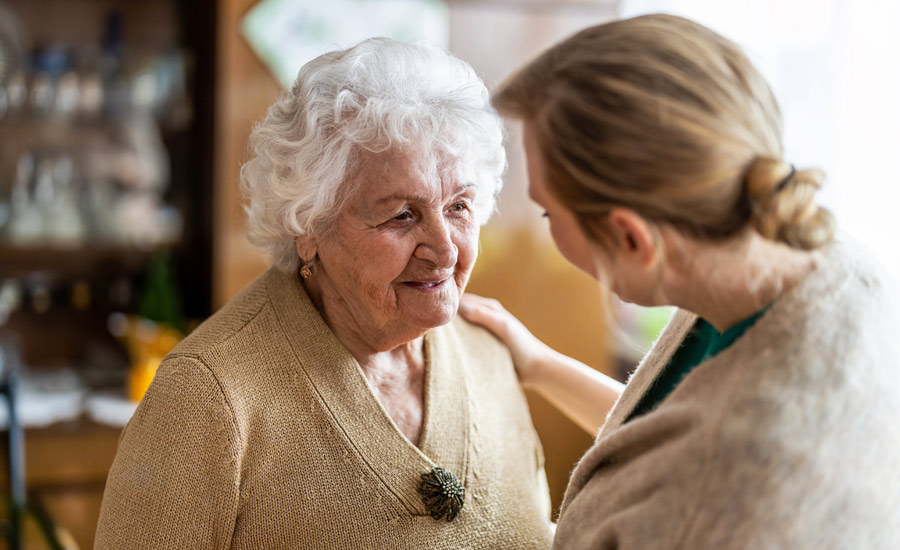Packing for a Visit: What’s Helpful to Bring to a Dementia Care Home

It’s not always clear what to bring when visiting someone with dementia. You might want to take something to make the visit more comfortable, but it can be hard to know what will help and what might cause confusion.
Keep reading as we offer some practical suggestions to help you feel more prepared.
What Should You Bring When Visiting a Dementia Care Home?
Bring one or two familiar items that feel safe, calming and easy to engage with. This might be a photo, a soft item of clothing they used to wear, a book to flick through or a snack they’ve always liked. Avoid anything noisy, unfamiliar or likely to confuse. Keep it simple and let the visit guide how you interact with your loved one.
Familiar Items Make a Difference
Choosing the right things to bring to a dementia care home matters more than you think, and here’s why:
1. Familiar objects tap into remembered routines
A 2021 ethnographic study found that when people with dementia visit familiar places or handle familiar items, they draw on a sense of continuity that helps them feel present and less disoriented. Bringing something from home, like a well-worn scarf or an old cuddly toy, can reinforce that feeling of “this is my world”.
2. Personal items improve recognition and use
In one lab study, individuals with Alzheimer’s named or used their own familiar objects significantly better than generic or clinical versions. They spoke more, gestured more accurately and connected more meaningfully with personal items, so your choices really do make a difference.
3. Familiar routines reduce stress
Maintaining familiar patterns, like opening a familiar snack or folding a known tea towel, can reduce confusion and agitation. Research on daily routines shows that this promotes calmness and well-being for your loved ones with dementia.
Helpful Things to Bring to a Dementia Care Home
Here are some things to help make your visit feel more familiar and focused:
- A small photo album or a few loose prints
- Well-known items of clothing (scarf, jumper, hat)
- A familiar handbag or wallet
- Some magazines they used to read
- Books they liked, even if they won’t read it
- A soft item they can hold (think cushion, fabric square or small blanket)
- Simple snacks they’ve always enjoyed (check with staff first)
- Scented hand cream that they used to use
- A hairbrush or compact mirror
- Something small from home (check if it’s appropriate with care staff first)
- A packet of tissues (sometimes just the act of taking one out is grounding)
- Music playlist on your phone – use headphones or a low-volume speaker
- A clean flannel or towel to fold
- Buttons, cards or objects to sort by shape or colour
- A postcard from somewhere familiar
- Small pack of cards
- A piece of fabric in a texture they used to wear, e.g. wool or satin
- Newspapers from the week or month they like to talk about
What Not to Bring
Some things can cause confusion, distress or overstimulation even if they seem harmless:
- Loud or unpredictable noise, like musical toys or noisy packaging
- Bright flashing devices or screen-based games
- Strong smells like perfume, candles and heavily scented products
- Complex or unfamiliar gifts
- Items that might remind them of someone they’ve lost, if they tend to find it distressing
- Food or drink without checking with the staff
- Objects that are sharp, fragile or easily swallowed
- New gadgets that need explaining
- Books or photos with heavy emotional weight
- Anything breakable or difficult to clean
- Decorations or trinkets that could be mistaken for food
- Too many items at once, because clutter can be overwhelming
Making the Visit Work for Them
What you bring to a dementia care home can make a real difference, but you don’t need to overcomplicate it. Just try one or two familiar items at first and you’ll find that’s often enough to support a calmer, more comfortable visit. Be aware of what feels right for them without panicking about filling the time or doing it perfectly. When it comes to visiting a loved one with dementia, often, it’s the smallest things that help the most.
Ready to explore...
